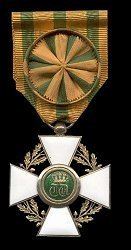Status Currently constituted | ||
 | ||
Type Chivalric order with five grades Motto Je maintiendrai ("I will maintain") Day Only awarded on Grand Duke's Official Birthday (23 June) which is also the National Holiday Eligibility Eligible to members of government, deputies, state councillors, civil servants, elected representatives and personnel of municipal administrations, key players of the economic, social, cultural or sport sectors as well as to volunteers. Can also be awarded to foreigners. Awarded for Luxembourg citizens who performed outstanding civil and military services, as well for distinguished artists who made outstanding achievements. | ||
The Order of the Oak Crown (French: Ordre de la couronne de Chêne, German: Eichenlaubkronenorden, Luxembourgish: Eechelaafkrounenuerden) is an order of the Grand Duchy of Luxembourg.
Contents
History
The Order of the Oak Crown was established in 1841 by Grand Duke William II who was also King of the Netherlands. At that time, the Grand Duchy of Luxembourg and the Kingdom of the Netherlands were in personal union which means that both nations had the same person as head of state although being two distinct and independent countries. Although the Order was legally a Luxembourgish decoration, it was often used by William II and his successor, King-Grand Duke William III, as a house order of the Nassau dynasty to reward Dutch subjects, beyond the control of the Dutch government.
William II conferred the order on fewer than 30 recipients. His successor, William III, liked the ability to confer this Order by his sole discretion, and awarded 300 decorations on the day of his coronation alone. In the following years hundreds of additional awards of the Order were made. Indeed, there were so many recipients in the kingdom of the Netherlands itself that the Order was widely (and falsely) regarded as a Dutch decoration.
The Order of the Oak Crown ceased to be awarded to Dutch subjects in 1890, when Queen Wilhelmina, as the only remaining member of the House of Orange-Nassau, succeeded her father as new Queen of the Netherlands. Since the Erneuter Erbverein, the Salic Law-based house-treaty between the two branches of the House of Nassau (the junior branch of Orange-Nassau and the senior branch of Nassau-Weilburg (present-day Luxembourg-Nassau)), did not allow women to succeed to the throne of Luxembourg as long as male heirs of the House of Nassau (in both branches) existed, the throne of Luxembourg went to a German relative of the new Dutch queen, also her maternal great-uncle Adolphe, Duke of Nassau, who became Grand Duke of Luxembourg at age 73. The Order of the Oak Crown remained a solely Luxembourgish decoration; subsequently the Netherlands established the Order of Orange-Nassau instead.
Since the accession of Grand Duke Adolphe, the Order has been primarily a decoration for Luxembourgish citizens, although it has occasionally been conferred on foreigners, mainly on members of foreign Royal families or on eminent foreigners with Luxembourgish ancestors.
HRH the Grand Duke of Luxembourg is the Grand Master of the Order.
Origin
After the abdication of King-Grand Duke William I in 1841, his successor William II granted Luxembourg a written anti-liberal constitution (called the Charter) in order to strengthen his authority over the country. At the same occasion, he established the Order of the Oak Crown with the idea to be able to award loyal supporters of his regime in liberal-minded Luxembourg.
The badge, the ribbon, and the (then) four-class hierarchy of the order were inspired by the Russian Order of St. George. This was probably due to the fact that William II was married to a daughter of Emperor Paul I of Russia, and that he had received the Order of St. George for his meritorious command in the Battle of Waterloo.
Grades
Nowadays the Order consists of five grades:
- Grand Cross - wears the badge on a sash on the right shoulder, and the plaque on the left chest;
- Grand Officer - wears the badge on a necklet, and the plaque on the left chest;
- Commander - wears the badge on a necklet;
- Officer - wears the badge on a chest ribbon with rosette on the left chest;
- Knight - wears the badge on a chest ribbon on the left chest;
plus gilt, silver and bronze medals, who wear the medal on a chest ribbon on the left chest.
